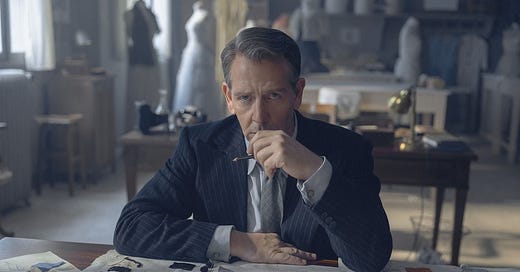I find fashion fascinating. I’ve designed clothes in my head since I can remember. To fall asleep as a young child, I would imagine myself in a flowing gown, inspired by Pinkie, Thomas Lawrence’s 1794 portrait of Sarah Gooden Barrett Moulton. (We had a children’s book of famous art, and that was one of my favorite illustrations.)
My great grandfather was a Konfektionär in Berlin in the 1920s who designed and made women’s ready-to-wear clothing. His daughter, my maternal grandmother, learned at his feet and was an elegant woman with a distinctive style. From her I learned to appreciate quality fabric and design, and she instilled in me a love of sewing and textiles. What I choose to wear each day is a mode of creative self-expression and communication.
So, when I heard of The New Look, an Apple TV+ series about Christian Dior and Coco Chanel in Paris during World War II, I had to watch. Centered on the origin story of the House of Dior, the series explores the complex moral choices that each designer made to rescue family from the Nazis and save their couture houses.
While some Paris designers closed their ateliers during the war, others remained open to preserve their businesses and keep their employees fed, but at a price—designing fashions for the wives of Nazi officers. We follow Dior (Ben Mendelsohn) as he struggles to comply with that decision by his mentor and employer Lucien Lelong (John Malkovich) and his agonized efforts to protect his sister, Catherine (Maise Williams), a committed member of the French resistance.
Dior’s evolution and artistic conviction to negate the war’s destruction by creating beauty on his own terms is interwoven with the conniving machinations of Coco Chanel (Juliette Binoche), who shutters her fashion house when the Nazis invade and works her connections to save her nephew from imprisonment, but eventually collaborates with Nazis to save her brand and fortune.
Much has been written about the series and whether its depiction of Chanel’s complicity with the Nazis goes far enough. Others have bemoaned the fact that the famous styles that Dior designed after the war, which defined what Harper’s Bazaar dubbed “The New Look,” make too brief an appearance in the 10-part series. This is, after all, a story about high fashion as an art form and the role that couture played in defining French culture.
What I found wanting, however, was a fuller sense of the real struggle and deprivation of that era. To the credit of series creator Tod Kessler, a great deal of attention was paid to period details. Scenes were shot in Paris at the actual locations where events took place. Costume designer Karen Muller Surreau worked with the Dior archive to source fabrics and even X-ray period clothes from their collection to understand how they were constructed. The cinched waists, broad shoulders, voluminous skirts, and pastel chiffons of Dior’s 1947 collection evoke his vision of post-war abundance and elegance.
But the world of Vichy France was not all high society soirees with Nazis and their French collaborators, or collusion in Chanel’s hotel rooms at the Ritz or in Switzerland. There are some horrific scenes of Catherine Dior’s ordeal in Nazi captivity, but her post-war recovery from that trauma seems inordinately quick. And there is barely any mention of the tens of thousands of French Jews who were ostracized, persecuted, deported to death camps, and murdered during the war.
I also never had a sense of the daily struggles of Parisians to survive under Nazi occupation, for any of the lead characters or those around them. And this brings me back to the subject of fashion. In every scene, except those that involve Nazi torment and imprisonment, everyone is immaculately dressed. Despite lack of food and fuel and comforts, all the Parisians still wear pristine clothing.
Costume designer Surreau reportedly took the extra steps of weathering outfits so that they would look worn, but I could not discern the effect. Despite Dior’s emotional odyssey, the most disheveled that he ever appears is with a slightly loosened silk necktie and a barely rumpled white shirt. In crowd scenes, the Parisians are all perfectly outfitted, even if their clothes are more humble. I could go on.
Like I said, I’m fascinated by fashion. But the beauty of all the clothing in The New Look actually became a distraction that interrupted my immersion in the story. Detail worked against believability. With the exception of Chanel, who was a wealthy, successful businesswoman when the Nazis invaded, I kept wondering how everyone was able to look so good in the midst of such strife.
World-building in historical fiction is a complex art. Research is essential to discovering the defining details that create a sense of authenticity. But when the details are so buffed and polished that they outshine, rather than serve the story, they lose their value. In The New Look, a commitment to fashion detail ends up undercutting the serious questions that the series poses: Is the creation and wearing of beautiful clothing a redemptive art form that inspires and uplifts us from life’s deepest sorrows? Or is it merely a dalliance of the privileged few?





Evie, I didn’t know about this series. I love fashion too. Didn’t know your family was in clothing business. As you may remember, my Mom probably survived War with her sewing skills.
I definitely remember your Mom’s story. Thank goodness she was a skilled seamstress.